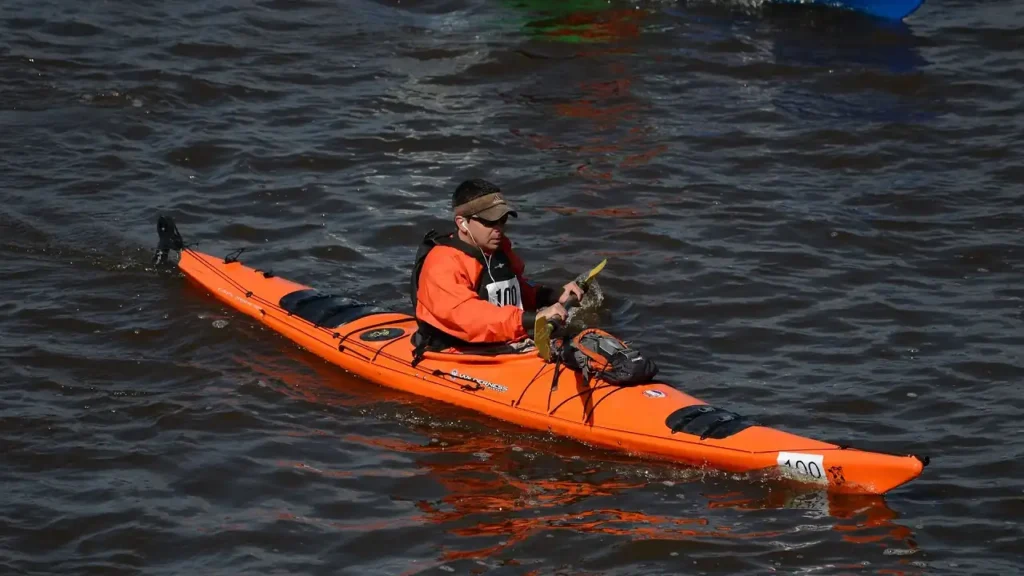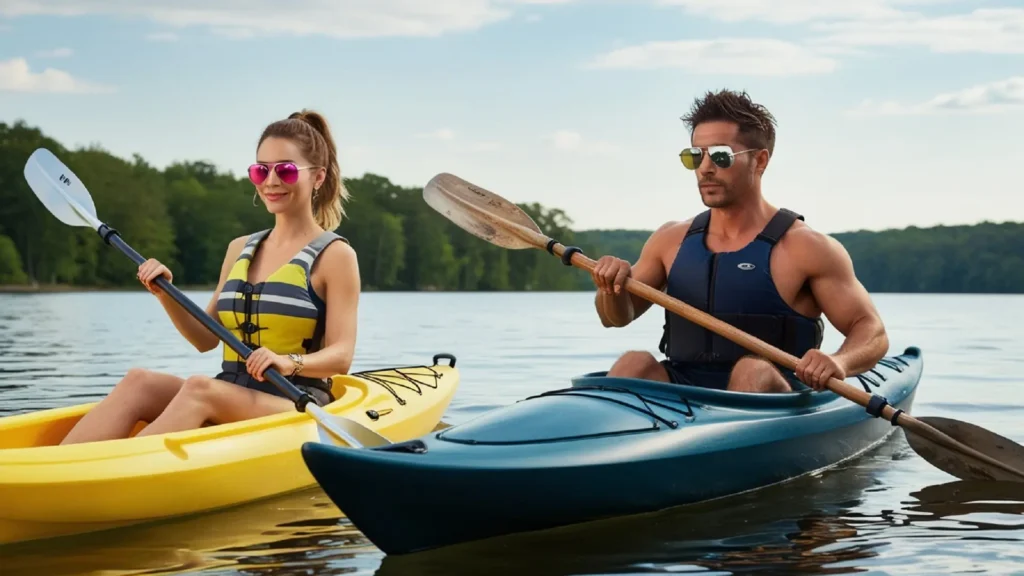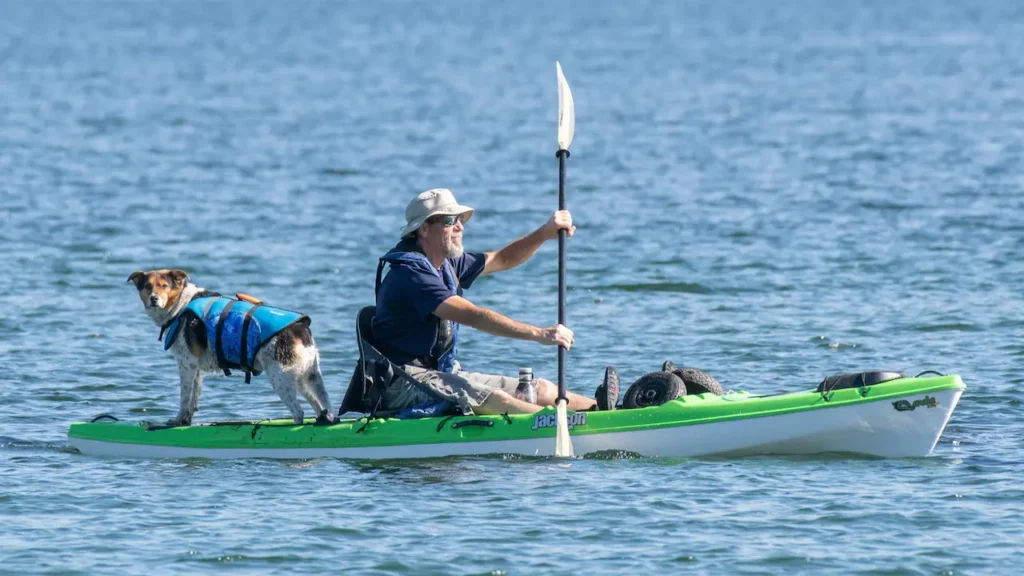A Personal Flotation Device (PFD) is an essential kayaking gear. A well-chosen PFD ensures safety and saves live. You need a good quality PFD when navigating calm lakes, paddling through whitewater rapids, or exploring the open sea.
With so many options available, choosing the right PFD can seem overwhelming. This guide will provide you with the details you need to make an informed decision.
What Is a PFD?
A PFD, or Personal Flotation Device, is designed to keep you afloat in the water. It reduce the risk of drowning in different kinds of water activities. Unlike traditional lifejackets, which are bulkier and designed for emergencies, PFDs are often more comfortable and tailored for active use in sports like kayaking, canoeing, and paddleboarding.
PFDs for kayaking are specifically designed with features that enhance mobility, comfort, and functionality.
Types of PFDs for Kayaking
Kayaking PFDs come in different styles, sizes and purposes.
Understanding these can help you narrow down your options:
Standard PFDs
They are made of foam which gives them inherent buoyancy and ultimately safety. The buoyancy of a standard PFD typically ranges from 15.5 to 22 pounds. This buoyancy helps you to keep you afloat in water after capsizing.
They are reliable in accident and emergency and requires minimal maintenance. Standard PFDs are ideal for high-risk activities like whitewater kayaking. They are available in various styles, including vests, jackets, or belts, and can be worn over clothing or alone.
Inflatable PFDs
Inflatable PFDs are typically smaller and lighter than Standard PFDs. They often consist of a vest or belt-style design, and when deflated, they are less bulky. Many inflatable PFDs are worn as a belt pack or chest harness. They provide significant buoyancy, usually ranging from 22 to 35 pounds.
These PFDs inflate using a CO2 cartridge, either manually or automatically. After use, the PFD must be re-armed with a new CO2 canister, and the inflation chamber needs to be checked for any punctures or damage.
These PFDs require the wearer to pull a cord or handle to trigger the inflation. This is typically used for activities where the wearer may not expect to fall into the water immediately but wants a more compact and less bulky PFD when not in use.
They are less suitable for situations where you might frequently get wet, such as whitewater kayaking. They need some manual operations for floating in water. For recreational kayaking, inflatable PFDs are a good option.
Hybrid PFDs
They create a balance between standard PFDs and inflatable PFDs. Actually, it is a combination for foam and inflatable elements. They come with manual and automatic inflation, giving the wearer the flexibility to control when it inflates, with the backup of automatic inflation in case of unconsciousness or sudden immersion.
They are ready to provide you immediate comfort and inherent buoyancy.
These are less common but can be a versatile option for varied kayaking conditions.
Key Features to Consider
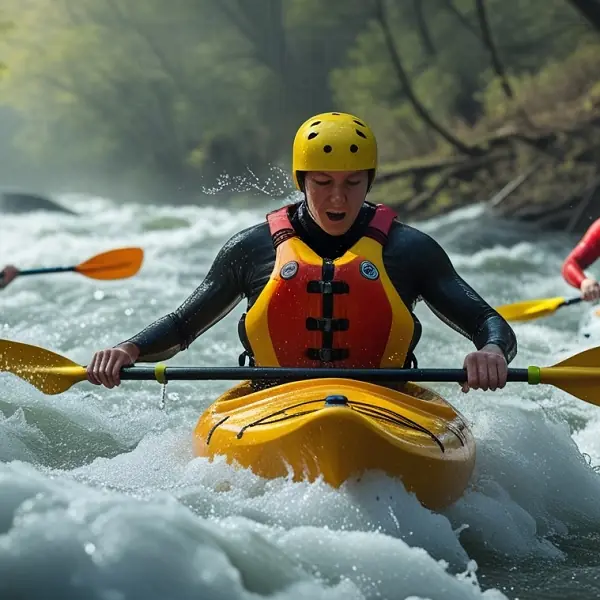
PFDs come in different qualities. They have many features for different purposes. Focus on the features below to consider when selecting one for you.
Fit and Size of a Perfect PFD
A good PFD hugs your body snugly. It lets you move freely on board and in water. They have straps and easily adjustable. You can bind the PFD around your shoulders, sides and waist so that it can float you in water.
A PFD should not be oversized. Choose one to match your chest size and weight range. A proper fit ensures the PFD won’t ride up or slip off in the water.
Try the PFD on with your kayaking clothing to ensure compatibility. This features lets you breath openly and doesn’t make your body cramped.
Consider Mobility and Comfort
Paddling requires enough spaces between the legs. It needs freedom of your arms to ride the kayak. Keep your arms relaxed and movable when on board. Look for PFDs with large armholes and short torsos that don’t interfere with your paddle strokes.
Many kayaking PFDs have mesh backs or high-back designs to accommodate kayak seatbacks.
Light materials provides comfort. They are easy to carry and wear. Opt for PFDs which are lightweight and have padded straps for extended comfort.
Buoyancy Saves Life
Buoyancy is important for your safety. Choose PFDs which have higher buoyancy. PFDs are rated by their buoyancy, measured in pounds. For most kayakers, 16-18 pounds of buoyancy is sufficient.
Choose a PFD with buoyancy of more than 20 pounds for heavier individuals. Extra buoyancy gives you an option to carry extra gears.
Read the safety ratings before buying any PFD. Ensure the PFD’s buoyancy rating meets safety standards for the type of water you’ll be paddling in.
Materials and Durability of PFDs
Nylon lasts for many years. Look for PFDs made of durable nylon or polyester shells to resist wear and tear. It is cost effective and provides safety.
Your PFDs need to be dried up quickly for some reasons. UV-resistant coatings and quick-drying materials improve longevity and comfort.
Inspect the stitching and hardware, like zippers and buckles, for quality. Make sure they are clogged. This reduces stress and requires less energy when submerged.
Measure Safety First
Go for bright colors. Bright colors and reflective accents improve visibility in low-light conditions. White colors and orange reflects best in day light and low light. You can go for yellow and red, if you prefer them. If you don’t like this, choose light green. They are visible from distance in emergency and can be rescued with more ease. In this situation, the brightest color is the best color.
Whistles, attachment points for safety knives, and tabs for strobes can be lifesaving additions. Choose a PFD which has a lot of pockets to carry a lanyard and other safety gears. The whistles should be attached with the lanyard and kept in the pocket to reach your mouth in risky moment.
Storage and Pockets of PFDs
Many kayaking PFDs include zippered pockets for stashing snacks, maps, sunscreen, emergency gears or a small first-aid kit. Generally, you will get them in standard PFDs which are also recommended for whitewater kayaking by many experts.
You need pocket for storing safety gears. Some electronics pocket holds a handheld 6/2.5/1-watt VHF radio. This is very valuable to save your life. You can depend on radio when kayaking solo.
Choose a PFD with secure, easily accessible storage that doesn’t add bulk or restrict movement. Pockets in PFDs should be arranged and organized.
Choose PFDs Depending on Kayaking Styles
Paddlers prefer recreational kayaking on a calm lake or slow-moving rivers. Recreational kayaking are less risky and you may get enough time to maintain a PFD in the moment of emergency. Opt for PFDs that brings comfort and are lightweight and require less maintenance.
Whitewater kayaking offers thrill and excitement of whitewater environment. They include several styles like river running, creeking, slalom, playboating, and squirt boating. Opt for rugged PFDs with higher buoyancy and extra safety features like rescue harnesses. Choose PFDs that can keep you afloat in whitewater when capsized without any extra effort.
Sea kayaks are seaworthy small boats with a covered deck and the ability to incorporate a spray deck. Sea kayaking is suitable for marine journeys from a few hours to many weeks. Look for PFDs with additional storage for gear and features like reflective strips for visibility.
See Certification and Standards
Ensure the PFD is certified by a recognized authority like the U.S. Coast Guard (USCG), Transport Canada, or ISO/CE. They have formulated some guidelines and requirement of PFDs for the safety of the kayakers. They advise you regarding questions arrived in your head so that you don’t have to be worried next time. Read their guidelines before buying any PFDs. It will save you time, money and life.
Certifications indicate the PFD meets safety requirements for specific water conditions. United States Coast Guard have advised you to select PFDs depending on your weight. Look at the chart below-
Type PFDs | Minimum Adult Buoyancy in Pounds (Newtons) |
I – Inflatable | 33.0 (150) |
I – Buoyant Foam or Kapok | 22.0 (100) |
II – Inflatable | 33.0 (150) |
II – Buoyant Foam or Kapok | 15.5 (70) |
III – Inflatable | 22.0 (100) |
III – Buoyant Foam | 15.5 (70) |
IV – Ring Buoys | 16.5 (75) |
IV – Boat Cushions | 18.0 (82) |
V – Hybrid Inflatables | 22.0 (Fully inflated) (100) |
V – Special Use Device – Inflatable | 22.0 to 34.0 (100 to 155) |
V – Special Use Device – Buoyant Foam | 15.5 to 22.0 (70 to 100) |
Special Considerations for Different Kayaking Scenarios
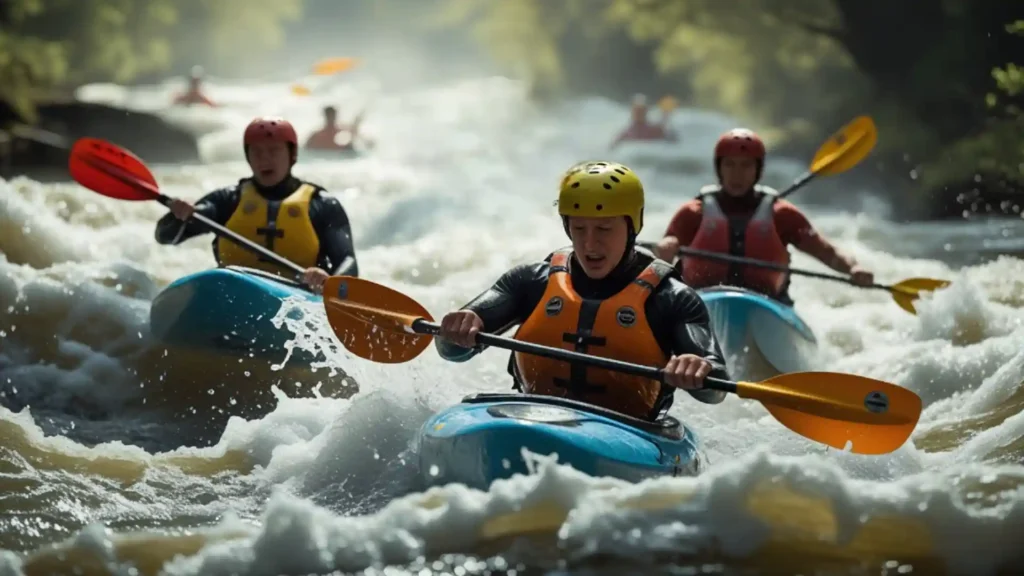
Whitewater Kayaking
Choose Type V PFD with rugged construction and high buoyancy. Type V PFDs provide safety in more demanding situations and specifically designed for emergency rescue. They aren’t that much comfortable but have a buoyancy of 15.5 pounds and more.
Look for features like rescue harnesses and reinforced shoulder straps for added safety. Ensure the PFD allows quick drainage and doesn’t become waterlogged.
Sea Kayaking
Opt for a PFD with plenty of storage pockets for flares, navigation tools, and communication devices. High visibility is crucial, so choose bright colors with reflective elements. Consider models with hydration pack compatibility for long-distance paddling.
Recreational Kayaking
Prioritize comfort and ease of use. Lightweight PFDs with minimal bulk are ideal. Mesh backs and ventilated designs are great for warm weather and casual paddling. Storage pockets can be useful but aren’t as critical as in more demanding kayaking types.
Fishing Kayaking
Anglers often prefer PFDs with built-in storage for tackle, tools, and gear. Look for options with attachment points for fishing accessories and rod holders. A high-back design ensures compatibility with fishing kayak seats.
Fitting and Testing Your PFD
Wear the PFD and adjust all straps until it fits snugly. It should not ride up or feel loose. Move your arms and simulate paddling motions to ensure the PFD doesn’t restrict movement. Test the PFD in calm water to confirm it provides adequate buoyancy and keeps your head above water. Check for any signs of wear, damage, or discomfort during the test.
Common Mistakes to Avoid When Choosing PFDs
Choosing the Wrong Size: A poorly fitting PFD can compromise safety and comfort. It downgrades your performances and hampers technique implementation. Choose PFDs in respect to fit and mobility.
Neglecting Certification: Always ensure the PFD meets recognized safety standards. Read them thoroughly and buy according to the guidelines.
Ignoring Buoyancy Needs: Underestimating buoyancy requirements can be dangerous in rough water. Generally a 15 pound buoyancy is enough. Go for higher buoyancy if you are bigger in size and weight.
Skipping a Float Test: Testing your PFD in water ensures it functions as expected. Always check them before boarding on your kayak or canoe. It can save your life by ensuring safety.
Using a Damaged PFD: Check straps and foams. Replace your PFD immediately if it shows signs of significant wear or damage.
A well-chosen PFD is your most important companion on the water. They offer safety, comfort, and peace of mind. By considering factors such as fit, buoyancy, materials, and intended use, you can find the perfect PFD for your kayaking adventures.

